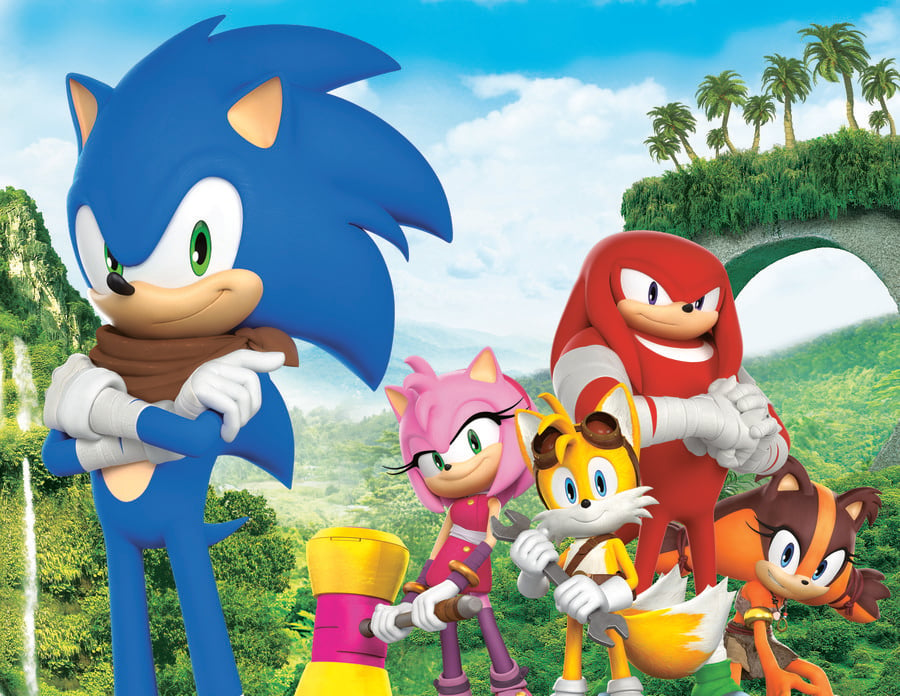
Back in May 2013 Nintendo announced that it had entered into a partnership with Sega to bring a series of three Sonic games exclusively to its systems. Sonic Lost World and Mario & Sonic at the Sochi 2014 Olympic Winter Games were the first products of that arrangement, and the upcoming Sonic Boom games — one on Wii U and one on 3DS — are set to round out the trio. Sega has an ambitious multimodal strategy for Sonic Boom, including a TV series on Cartoon Network, a line of TOMY toys and, of course, the two separate Nintendo-exclusive games: Sonic Boom: Rise of Lyric for the Wii U, and Sonic Boom: Shattered Crystal for the 3DS.
There’s been a recent trend for console and handheld versions of the same Sonic games to have different levels, features, and individual emphases — as with Sonic Generations and Sonic Lost World — but the two Sonic Boom titles we saw at E3 take that idea even further. In reality, these are entirely separate games — a fact reflected in their subtitles and emphasized repeatedly by members of both development teams. After spending time with both games on the show floor, we definitely agree; while they’re connected by story, setting, and the Sonic Boom moniker, Rise of Lyric and Shattered Crystal represent two exciting and decidedly different directions for Sega’s evergreen Blue Blur.

Sonic Boom: Rise of Lyric (Wii U)
We first got to try out Sonic Boom: Rise of Lyric, developed by Big Red Button for the Wii U. The demo we played was split into four sections, each designed to showcase a different aspect of the gameplay: exploration, combat, boss battles, and speed. We began with the exploration area, and right off the bat it was clear that this is a very different experience from past Sonic outings — our play session even started with a gentle reminder that Rise of Lyric is “not a traditional Sonic game, and that’s key”.
The level we played featured two playable characters — Sonic and Knuckles — which we could switch between with a press of the D-Pad. We were told that each exploration stage will focus on a team of two of the game’s four heroes — Sonic, Knuckles, Tails, and Amy — and the level designs will emphasize two-player cooperative play. Each character also has different strengths and abilities; Sonic is predictably speedy and can spin-dash, Knuckles is unusually strong and can climb, Tails can hover and use tools, and Amy can triple-jump, cross balance beams, and smash in enemies with her hammer.
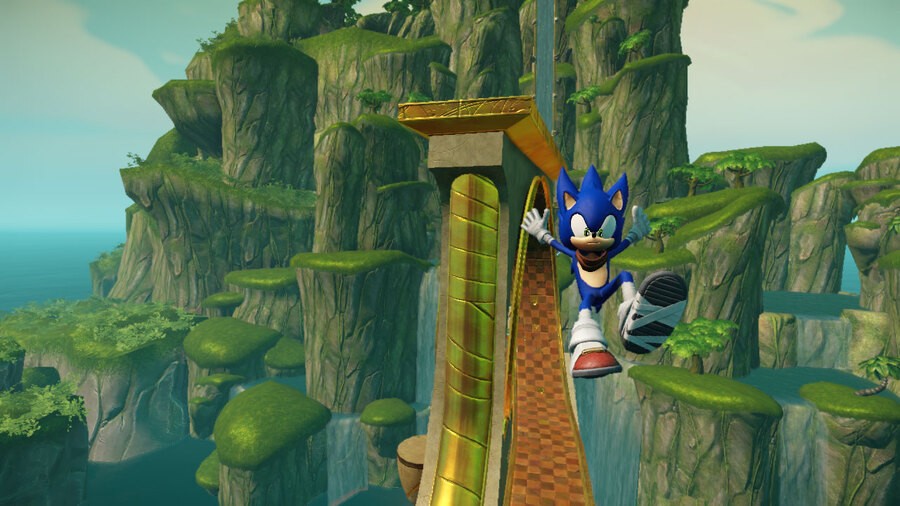
A Big Red Button rep told us that “from the beginning, the desire was to create an experience that people could sit down and play together”, and though we weren’t able to try it on the show floor, the full game will feature two-player dual-screen co-op: one player will use the GamePad as both controller and screen, while the other will use a separate controller and watch the TV in order to capitalize on the “sense of surprise” that comes from two people exploring the same level independently. Co-op will also be drop-in and drop-out, so that if one player needs to leave the AI will take over.
Our experience with the demo was of the single-player mode, with the computer controlling our ever-present sidekick, and the gameplay reminded us more of GameCube-era 3D action-adventure games than anything else; in the Sonic universe, the slower-paced exploration portions of Sonic Adventure would be the closest parallel. We took Sonic and Knuckles through several different areas in a jungle-like outdoor base, hitting switches to open doors, taking out enemies, and solving simple puzzles to advance. Many of these puzzles involved using a new element in the series called the ‘Enerbeam’ — a laser-like electric force that serves as both lasso and grappling hook — to drag things around, trigger distant switches, or pull platforms towards you.
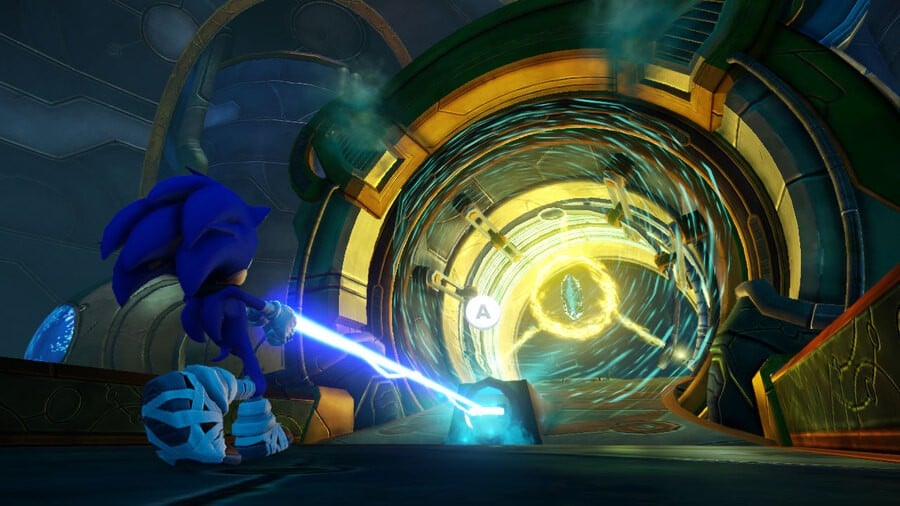
The level design also took advantage of the two-character dynamic; Knuckles activated his end of two-part switches when required, and split off each time we reached one of the stage’s many branching paths. One section, for instance, featured a fork with spin-dash pads (which only Sonic could use) on the left, and a sheer wall (which only Knuckles could climb) on the right; we were free to decide which path we wanted to take by switching between the two characters, and each choice offered up different collectables and secrets.
Perhaps the biggest change of pace in Rise of Lyric from traditional Sonic gameplay comes from the combat. In place of Sonic’s usual hop-and-bop hit-and-run, Rise of Lyric features much more involved melees, with plenty of different ways to whop your foes. Along with homing attacks, players can use combos, charge moves, ground pounds, and evade rolls to deal with enemies, many of whom take several hits to finish off. The Enerbeam also plays a large role here — we used it to pick up and toss baddies into both the environment and each other, as well as remove shields from more powerful enemies before they could be damaged.
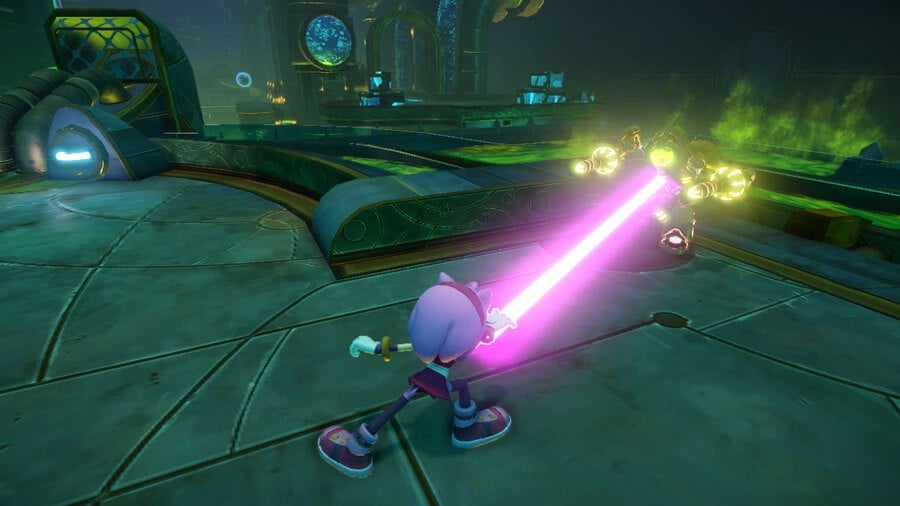
The conventional ring-based hit-point system of the Sonic series has been revamped as well; instead of operating on a rings-or-no-rings basis, Sonic and his friends now use the golden loops as health. Each character starts with a certain number of rings — represented in a visual health bar — and you’ll loose them as you take damage, with stronger enemies and harder hits resulting in bigger losses. Running out of rings won’t send you to a Game Over screen, either; as long as your partner is still standing, you’ll come back after a brief countdown, and if both characters fall at once you’ll simply restart from the last checkpoint.
Between the emphasis on combat and the decidedly slower pace, the gameplay in the exploration section of the Rise of Lyric demo felt very little like what we’ve come to expect from a Sonic game. That’s not necessarily a bad thing, however; what we played was an enjoyable slice of a 3D adventure game, and — perhaps crucially for the game’s primarily young intended audience — full of character. Plenty of banter between Sonic and pals — fully voiced by the voice actors from the upcoming TV show — kept things lively with wholesome humour, and in a nice touch we caught glimpses of Amy and Tails at several points throughout the level, busy working on their own mission independently.
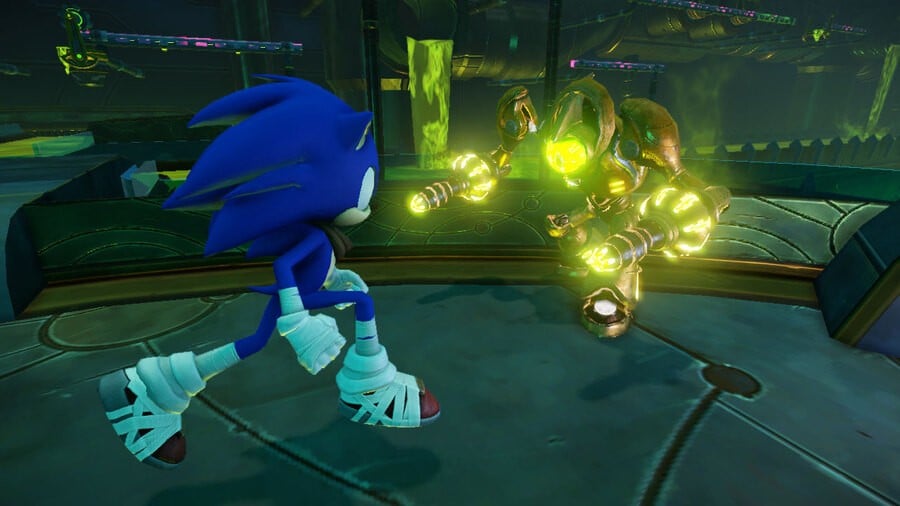
We ended our time with Rise of Lyric by taking a look at the speed section of the demo, which featured a short beach-themed course for Sonic & Co. to blast through. This portion felt the most familiar from past Sonic games: we guided our four heroes along an on-rails trail full of boost pads and loops, sidestepping between three different lanes, activating railroad-style switches to trigger alternate paths, and making lots of last-minute jumps. One big change from the Sonic norm is that there were no bottomless pits; when we missed a zipline and feared the worst, we simply touched down rather unceremoniously into a lower area, and were able to work our way back up again, slowly but surely. The Big Red Button rep told us that this was part of an intentional plan to minimize frustration, and that the punishment for missteps in these sections would be slowing down, rather than starting over — definitely a plus for a younger audience and those not enamoured with the jump-or-die design of earlier Sonic games. We enjoyed the sunny speed course we tried, and though it was over quickly and rather basic, we were told they become more elaborate in both setting and level design as the game progresses, and that speed sections will be found within levels, as paths between hubs and individual levels and within hub worlds themselves.
Sonic Boom: Shattered Crystal (3DS)
After running around in Rise of Lyric, we switched gears to try out Sonic Boom: Shattered Crystal on the 3DS, and speak with Tim Guerrero, Vice President & Creative Director of Sanzaru Games, developer for the handheld title. Shattered Crystal, Tim explained, has an entirely different gameplay focus from its console counterpart: it’s rooted in old-school side-scrolling Sonic, with an added element of exploration that comes from both the level design and its four playable characters.
While both Sonic Boom games feature teams of four, the roster is a bit different in Shattered Crystal; you’ll still be able to play as Sonic, Tails, and Knuckles, but since Amy’s been kidnapped you’ll instead take control of Sticks, a feral jungle badger and Amy’s best friend. You can switch between all four on the fly — even in the air — and though they all control alike, with a basic homing attack and dash, each character has different special abilities: Sonic can air-dash during jumps, Knuckles can punch and burrow, Tails can hover and toss grenades, and Sticks can throw a steerable boomerang.
In the Seaside Jungle stage we played, all of these abilities were used to reach new and otherwise out-of-reach areas, and switching quickly between characters for each situation felt great. In the course of our ten-minute run through the stage we air-dashed across wide gaps as Sonic, used Tails’ hover ability to ride breezes and his mechanical skills to pilot a submarine (named The Sea Fox, in a nod to Sonic Triple Trouble and Tails Adventure), tunnelled through special soft ground as Knuckles — calling to mind the Yellow Drill Wisp sections of Sonic Colours — and activated switches, took out faraway foes, and peeked around corners with Sticks’ surprisingly versatile boomerang.
It’s worth pointing out that while using the four heroes’ abilities to the fullest was the only way to find every secret in the stage, all of the areas we accessed through character-specific moves were completely optional. Sanzaru specifically avoided putting any multi-character ‘roadblocks’ between the player and the goal, in hopes that switching characters would feel fun rather than forced, and in our playtest that was certainly the case. It’s also a mechanic that could draw players back to earlier stages; while we were able to use all four characters in the E3 demo, normally only two would be unlocked by the time players reach Seaside Jungle, and some areas would remain off-limits until the team is completely assembled.
Just like the side-scrolling gameplay, the combat in Shattered Crystal recalls Sonic’s roots, with familiar hop-and-bop mechanics that make it quick, precise, and more about movement than pausing to eliminate foes. As in classic Sonic level design, enemies are “part of the flow” of a stage; they protect platforms, help you cross gaps, and feed into branching paths — we homing-attacked our way up several baddie-staircases, for instance, and were often well-rewarded for doing so. The Enerbeam is also used in Shattered Crystal, both for removing shields from enemies and for manoeuvring around the environment. Swinging across chasms via Enerbeam-enabled grappling points was particularly fun, and felt like a natural extension of the ‘flow’ of the game.
Along with the main platforming stage, we were also able to try out two other level types which will pop up from time to time on the game’s six island world maps. The first was a race stage, where we played as Sonic and tried to beat Sticks in an all-out dash to the finish line. It reminded us of the classic showdown with Metal Sonic from Sonic CD — in fact, we were told that you’ll even race Metal Sonic in the full game — and winning was all about quick decisions, split paths, and perfect timing. It was a close race from start to finish — though we narrowly squeaked in to victory — and lots of frantic fun.
The second side-stage we experienced was a 3D Worm Tunnel level, where Sonic races into the screen at top speed along a set path, avoiding obstacles and grabbing overhead rails with the Enerbeam in a one-shot attempt to make it to the end. This stage felt a bit like a much faster and more immediately treacherous version of Sonic 2’s special stages, and the combination of quick lane-switches, QTE-like jumps and Enerbeam-activation made for good twitchy fun.
Finally, while there won’t be any multiplayer in the handheld Sonic Boom, Shattered Crystal does feature StreetPass functionality. Each time you pass another player you’ll earn a special coin, and these can be exchanged for collectable ‘toys’ — 3D models and figures of characters and items — at shops on the world map. If you don’t have much luck with StreetPass, you’ll also be able to earn coins by playing a punching-bag mini-game with Knuckles, so players from less populated areas will be able to stock up on the in-game mementos as well.
After spending time with both Rise of Lyric and Shattered Crystal, it’s clear that Sonic Boom is best thought of as a Sonic ‘series’, rather than a game itself. Aside from the characters, gameplay, and narratives unique to each platform, each title had an entirely different feel; from our early impressions, it seems like the Wii U game could be a fun co-op experience for friends and families — especially those with younger children — while the 3DS title may hold more appeal for platforming and old-school Sonic fans. No matter your platform or play style of choice, Sonic won’t keep you waiting for long — both titles are set to be released in 2014, alongside the animated TV series, and we’re certainly looking forward to seeing the rest of what this new Sonic universe has to offer when they do.
Be sure to check out our other hands on features from E3:

Comments 73
I really hope this game will be a giod one, especially the Wii U version!
Rise of Lyrics sounds like the Sonic game I've been wanting for years! I've always wanted a bigger focus on exploration and the chance to play as Knuckles, Tails and Amy again!
I got Lost World and I do not think it is a bad game. It has annoying parts, and the game benefited from the later patch, but again I dont feel it is a bad game.
i think it looks horribly generic and the gameplay is boring, and the mayority agrees with me
Wii U version sounds like a Lego or Skylander game, or R&C:A4O, so this could be a good thing to play with the Mrs. while we wait for part 3 of the Hobbit to be released. My favorite Sonic game is still Adventure on the Dreamcast so Im ok with exploration and I really like 2 screen couch co-op.
To me this game is too much like Sonic Heroes. Soundtrack was great btw, but gameplay to me was very boring and i didn't like it that you could play with 3 characters as a group. Kinda sad they went down this road again
Does Sonic belong in a 3D World? After the past 2 games, I have my doubts that speed works in 3D, so this may be the compromise to make the game work.
Also, the attack system in Sonic LW is just hideous. I've just got round to start playing it from Christmas and it's so random when it works (especially against bosses), it makes the ridiculously hard for me at 34, let alone the target 7 year old audience.
I hope at least one of them will be great. It's been ages since I last played a Sonic game.
great thing the Sonic Boom in the 3DS is 2D, there are some cool 3D sonic games but the 2D ones are usually more fun to me.
Sonic games tend to be hit or miss, so it looks like I will have to wait for a review before I make any purchasing decisions. I used to be a HUGE Sonic fan and Sonic the Hedgehog 2 was one of the first games I ever played! I haven't touched much of the recent Sonic games since Sonic Adventure 2 and the demo of Sonic Lost World reminded me why. Something just felt off about that game, from the level design to the jumping, either way I decided that I was going to pass on that game and have since then I have doubts about future Sonic games. Hopefully these new teams can pull it off as these games, (as always ), are looking good at first glance. Though how good they are throughout the game is the real question!
In other words... Sonic 3DS = classic Sonic. Sonic Wii U = new. I'll be getting the Wii U version. We gotta support these guys.
I'm surprised that Shattered Crystal seems to be more fun than the Wii U one! May want to get the 3DS version instead.........please be a good sonic game SEGA.........
It don't know why so many people are bashing this game, it looks really fun. The developers have been upfront about the fact that this is a spinoff and non-traditional Sonic experience and, for the most part, the gameplay and cooperative-play mechanics look like a blast. The only criticism I have is that the enerbeam doesn't seem to be used all that creatively, but we've only seen a little of the game.
Super excited!
November's fast approaching!
@rjejr
"My favorite Sonic game is still Adventure on the Dreamcast so Im ok with exploration and I really like 2 screen couch co-op."
I can relate to that. SA was my first Sonic, and I actually loved the different mechanics for each character. The slower paced levels with Knuckles and Big were a nice change of pace to me. Besides having the camera behind you made it easier to run with Sonic and look at obstacles ahead of you.
I am very excited to play these.
I don't care if its not a traditional Sonic game, just that its a decent game at this point. I can't bring myself to finish Lost World. Not even sure if I'm able to with the difficulty.
Hearing that the game is comparable to Sonic Adventure is enough to grab my attention. SA and SA2 are my personal favorite Sonic games.
I'm starting to be a bit iffy with Rise of Lyric. I understand that this a different take, but no bottomless pits? Raging has always made a Sonic game for me. I'll still give this a try though, no chance of me not attempting to get hooked.
Change is good yes the Wii U game is a different pace but it is still cool to actually explore the world for a change. May end up being a button masher but the combat may be fun. This isn't a new thing they are doing so no one should be complaining
I'm cautiously optimistic, but the constant banter annoyed me to no end on the gameplay trailers I've seen.
@Reverandjames I feel the same way. I thought Sonic Lost World was going to be the next big thing for Sonic since Sonic Adventure.
For some reason it reminds me of Shadow the Hedgehog.
@Reverandjames I feel the exact same way.
I will get the 3DS one (And the multiplatform Sonic Team one whenever that comes out).
I prefer Lost World to anything else I have played on the Wii U so far. (Not tried Tropical Freeze yet but tried all the main other platfomers and 3D Platformers). Any game that you can finish without ever having to try to improve is not a game worth playing.
@bert0503 It reminds me of the bits of unleashed that I didn't like. (Or the type of stuff Sony seems to like).
Okay, this time ambitions seem to mesh together with hard work and good ideas! I'll keep an eye out for this!
I don't care about either of them.
Would much rather have another Lost World! I really hope they don't abandon what they did there, its an exceptional game.
Do my eyes deceive me? Did they say there will be a Metal Sonic race in the game!? HUZZAH!
The dual screen multi is the dark horse component of Rise of Lyric. No one has seen it, yet it's clear from everything we've seen that the levels are designed around that aspect being a defining feature, possibly even at the expense of single player. Still, there is one major hurdle considering the CryEngine BigRedButton is utilizing isn't geared to support split screen. It remains to be seen whether that can be cleared successfully.
Anyway, I've always felt there is promise. These impressions are commendable in that Morgan toils to find the primary potential, rather than overreact at first impression and fill the article with superficial quips. (See the many Splatoon impressions that barely scratch the surface of gameplay while focusing on the early controls, the ideal marketplace, and the unthinkable new IP.)
It's been a long time since my kids enjoyed a Sonic game and these sound pretty ideal for some some good old-fashioned family gaming, if nothing else. Why see them as anything less at this point?
I think I'll try both, not sure about Rise of Lyric though.
@sinalefa Good to hear. Been thinking about picking it up.
Call me crazy but this looks like fun to me, Sonic is stale and the hardcore 2d fans don't realize his type of game has become endless runners and 3D Sonic has never lived up to expectations because Sonic as he was just didn't suit 3D. I'll give it a chance and form my own opinion, i used to love Sonic but time has not been good to him at all.
I wish Sonic would just pull a "New Super Mario Bros" and do some good old fashioned 2D platforming again.
@vamkar
Haha, yeah I did see that earlier. It just feels out of place and so unlike Sonic.
I'm impressed and look forward to playing these. Is this Sonic "evolved" or just Sonic "altered"? Guess time will tell...
Cautiously curious about the WiiU version. The combat looks dull like werehog levels. However, I love that the speed sections have removed bottomless pits. For the 3D games that focus on speed, having bottomless pits just killed the flow of the game. I'd much rather the penalty be that I drop to a lower "line" that is less cool, less speedy, or has fewer good items.
I hope Rise of Lyric won't disappoint. I didn't like StLW demo and I didn't want that Olympic Sonic.
Happy Birthday, Sonic the Hedgehog!
@Superstick
I feel that NL's review was pretty fair with the score and their complaints. It can be infuriating as some parts are trial and error, but the patch that allows you to get a life every 100 rings helps with that.
@BLPs - "A4O with Sonic skins'
That's been my exact assessment since it was revealed. Only difference now is that this is only a 2-player game in story mode and fighting in 4 player, so it won't even be A40, more like A42. I still want it though.
It'll probably suck.
Cool! I look forward to owning both games & I look forward to watching the TV show, as long as it comes to Australia. I want Merchandise too.
Whenever they say traditional style gameplay I get excited... then I remember that SEGA seems to have no bleeping idea how to even do that properly anymore.
I've only played the demo of Lost World but for what it was, I enjoyed it. I hope the next "main" Sonic game expands on that style
lol why so much hate for Sonic?
i will give this game a chance and if isn't great well im done with sonic games.
What's the scarf all about?
@Reverandjames
I was also let down. But there's always hope. Even a clock is right twice a day, and we have two entirely different clocks this time around.
So.........was it fun?
Hope Sega is working on a follow up to Colors/Generations. I don't believe Lost Worlds furthered the franchise as in it just added another unnecessary gimmick that took away focus from the core Sonic formula. The hedgehog is still playing catchup to Mario.
Great job with the Clash reference in the kicker, Morgan!!!
@MoonKnight7 Its called Sonic 4 Episodes 1, 2 and Metal.
I am looking forward to same-couch co-op on Wii U playing with my wife. I love the idea of dual screens where we each have our own viewpoint (like in Hyrule Warriors).
I liked Lost World enough to play it to the end, but it didn't quite live up to the expectations i had for it. This looks promising, but I don't know how well it will pan out. I'm notoriously known to be broke in my family, so i'm gonna wait to buy this. I never really trust other's reviews, because everyone has different likes and opinions, so i'm definitely gonna want to try it for myself.
Seems like a positive reaction but not much time to play (only 2 of 4 types of game play tried in Wii U version, for instance).
I always like the idea of cooperative play so that's a plus and my kids gravitate to Sonic even though I don't think they've ever really enjoyed a Sonic game.
@GuyWithTheGames The majority agrees with you? How would you know something like that? Show me the data. :/
I know these games are quite a departure from typical Sonic games (for whatever stories there were, among other things), but I hope Super Sonic is still a part of this new Universe.
I have lost interest in Sonic games, and that kinda makes me sad
Bringing back elements from the Sonic Adventure series is a big plus for the Wii U version. I'm looking forward to see how this one turns out.
Ryse of Lyric is gonna be complete bull crap. The 3DS game is the only one that stands a chance. I got a thing for knowing when a Sonic game's gonna be bad. This is one of those Sonic games.
Morgan should admit that this game will suck big time.
looks terrible..
My best sonic days are behind me. I have no doubts it sells well. They all do
That makes me very excited for Sonic Boom! Both of them. Rise of Lyric sounds like a Sonic Adventure 3, which I've waiting for a long time, and SC sounds great too. The Buddy system brings in mind Sonic Advance 3.
I'm so glad there's at least one 3D platformer coming this year!! All this 2D nonsense needs to calm (I'm looking at you Nintendo), the 3D platformer is due, and needs to make a comeback.
@Ichiban I agree! And even the platformers that are 3D are always incorporating lots of 2D levels or 2D design philosophies (e.g. SM3DL/W).
Sonic games post Dreamcast have all been about cramming half baked ideas into what should be a simple platforming game.
They always mess it up by adding over the top stories, throwing in new characters no one cares about, and switching up gameplay modes mid game. How about 1 sonic game that's just about sonic platforming through beautiful scenery. No story other htan get to the end and beat robotnic?
@Knuckles
Meh... I mean you're right from a technical aspect, but still meh. Those were half-baked efforts.
"...slower-paced exploration portions", "...deal with enemies, many of whom take several hits to finish off."
Oh yeah. That sounds promising.
@Burning_Spear Cheers!! =D
@MrGawain in contrast, sonic lost world is easy for me at the age of 33. Often a 7 year old child adapts better than an older 34 year old adult.
I actually liked Sonic Lost World ... Don't see what the fuss is all about enjoyed the game. ... I'll give this a chance as I like the co op option
Sonic doesn't need anymore friends. They should have just added Big the Cat instead of Sticks. There is a lot of game play potential in being able to let Froggy go into secret passages and team up for combat . They could just keep his voice actor from the old games. Best Sonic game ever, right there.
(in case it isn't clear, I'm not serious)
Tap here to load 73 comments
Leave A Comment
Hold on there, you need to login to post a comment...